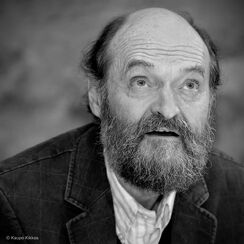Introduction []
Arvo Pärt is an Estonian composer. He was born in 1935 in Paide, Estonia. As a Christian, he developed his style relating things to the slow transformation of sounds that occur over time in things like bells and human voices. Since his music has a religious undertone, Pärt was able to gain a very large following later in his career. He served in the military, after that time he began his study of music in Tallinn, Estonia. He then went on to work for Estonian radio while also composing in his free time.

Work Analysis[]
For Pärt's music, I wanted to focus on his piece "Spiegel im Spiegel". This translates to "Mirror in the Mirror", and was composed in 1978. Pärt's music in his early years was very tense, but this piece was later in his career and is very pleasing to the ear. It starts with just a simple arpeggiation of a second inversion F major chord but as the piece progressed there are other parts that come in above and below the arpeggiation on the piano and a soaring violin like that holds out pitches. The arpeggiating piano line also varies over time, sometime going higher and some times lowering. Toward the end of the piece the piano soars to a very high arpeggiation, lowering itself each measure after until it returns to the original chord.

Arvo Pärt - Spiegel im Spiegel (audio + sheet music)
Comparisons[]
This is a more tonal piece that Star Child by George Crumb, but it utilizes the same concept of a certain sound developing over a long period of time with little to no dynamic change. Both Pärt and Crumb's pieces have that minimalist style of ambience where there are only a few sounds that fill the soundscape that entrance the listener. On the other had, Crumb's Star Child is much less tonal that Pärt's Spiegel im Spiegel. Pärt's piece has no accidentals in the piece. The most interesting part of the piece is that the violin and main piano are in F Major, but the other piano notes soaring above and below the main piano melody are in C Major. Being that this notation wise in being played in 2 different keys is interesting despite it not sounding dissonant whatsoever. even when the B flat does come into play in the main melody.
Observations[]
This was a very refreshing listen. You start to forget that not every single piece of the 20th century was atonal, there are still traditionally tonal pieces that fit into the unique aesthetics of each of these composers. There are many Pärt piece's that are very experimental, but this specific one resonated with not only his style, but also rebelling against the traditional means of what we think 20th century music is supposed to be.